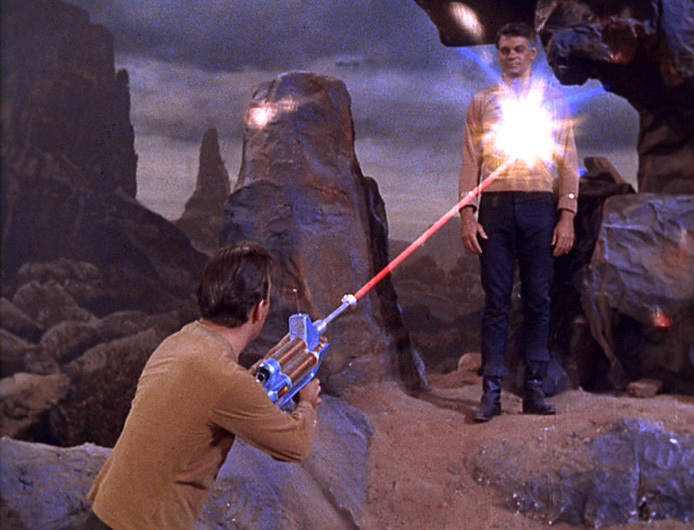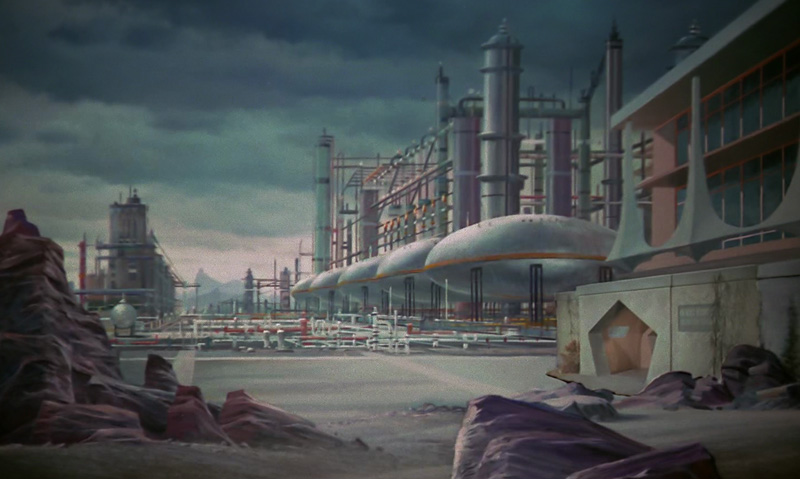
The Enterprise, under the command of James Kirk (William Shatner) attempts to cross the barrier between galaxies with disastrous results. The ship is badly damaged and Kirk’s old friend and navigator Gary Mitchell (Gary Lockwood) starts displaying weird powers (silver eyes, increased reading abilities, telekinesis, love of bad poetry) and a dangerous god complex. Kirk and Spock hatch a plan to cannibalize parts to repair the Enterprise from a nearby unmanned lithium-cracking station and to maroon Mitchell there. With the ship repaired, Mitchell escapes imprisonment on the planet and takes with him Dr. Elizabeth Dehner (Sally Kellerman), who was affected in a similar way to Mitchell but took longer to show symptoms. Kirk follows them and defeats and kills Mitchell, thanks to help from Dehner, who dies after the struggle. Kirk returns to the Enterprise and sets course for the ship’s next assignment.
Why it’s important
As the second pilot, this episode introduces Kirk, Scotty (James Doohan) and Sulu (George Takei), but it’s foundationalness (if that’s a word) as far as events go is sort of borderline. Few concepts about Earth, the Federation, Starfleet, etc., are introduced here that aren’t in “The Cage”. Most notable is probably talk of Starfleet Academy (where we learn Kirk was an instructor) which sort of underscores the idea of Starfleet as an exploratory/military-like service (along with the dialog about crossing the galactic barrier). There’s a general sense that humans explore the galaxy, but with few specifics — other than name dropping of some random planets and random stories re: alien “rodent things” that attacked Kirk and Mitchell back in the day.

The episode does introduce Kirk, who is an important person in galactic history (Sulu and Scotty, as well, to a point). It’s also an interesting sort of half-step between “The Cage” and “The Corbomite Maneuver” (the first episode filmed in regular production). We see the original uniforms but the ship looks more like what we see throughout the series (the colors are MUCH less muted).
As noted in our review of “The Cage,” this episode is Trek’s adventure pilot, because it sets up Kirk as the dashing hero (much more than Pike was in “The Cage”). Apparently, that was the goal of the second pilot — to be less cerebral, and this episode does a better job of balancing the cerebral with action. Still, Kirk’s dialog with Dehner about what Mitchell hasn’t learned in his accelerated progression to godhood is interesting stuff.
What doesn’t hold up well
The biggest issue is that this episode appears to take place well into the Enterprise’s five-year mission — which runs counter to established Trek history that says this episode was at the beginning of the five years (which sort of explains the lack of McCoy and less of a buddy-buddy relationship for Kirk and Spock). Also odd is the familiarity among the crew and lines about how some of them have served together for years.
There are also lines of dialog — Mitchell saying a poem written in 1996 is from the “past couple of centuries” — which show the creators hadn’t quite figured out a timeline for Star Trek. This is a problem for a lot of TOS, which seems to take place in the late 22nd century at some points (Kirk telling Khan in “Space Seed” that he’s been asleep for two centuries) and in the late 23rd at others (Kirk’s scenes with Dr. Taylor in “Star Trek IV: The Voyage Home”). It’s always been my theory that this stemmed from a belief, in the 1960s, that space exploration would be a lot farther along by the late 1990s than actually happened in real life — and the creators had to push back events accordingly.
Case in point: As the Enterprise gets close to the barrier, it finds the ship’s recorder from the S.S. Valiant, a vessel that apparently tried to leave the galaxy two centuries earlier (and ran into problems the Enterprise faces when it goes through the barrier). Do the math — this episode takes place in 2264 — meaning we’ll apparently have ships fast enough to get to the galactic barrier sometime in the next 86 years or so. Even if we accept the “Star Trek: First Contact” backstory, that humans travel faster than light in the 2060s, it’s just absurd to think we’d be traveling this far in the subsequent decades (and it certainly runs counter to “Star Trek: Enterprise,” in which humans don’t really leave the solar system until the 2150s).
But, as I said, the creators in 1966 probably thought we’d be a lot farther along with space exploration by now than we are — and probably never figured that, nearly 50 years later, geeks like me would be dissecting stuff at this level.
Of course, the other part of this problem stems from the issue of distance, something TOS really shrugged off most of the time with a wink and a nod. Even if you figure the Valiant somehow got to the galactic barrier in the late 21st century (wormhole, maybe?) the whole idea of the Enterprise making it there doesn’t hold up to scrutiny. This is just bad science, and we see it throughout TOS and in the movies.

And let’s say the Enterprise can get to the galactic barrier using conventional warp. How is there an unmanned lithium-cracking station so close — within reach on impulse — to the galactic barrier, which is, put another way, the edge of the galaxy? Are the unmanned ore ships that go there “every 20 years” according to Kirk really fast enough to get there — and for it to be worth it? Earth must really dig that lithium.
The Milky Way sure seems larger (appropriately so) in second-generation Trek.
Now, some of you — if you’re not trying to find a way to retcon this stuff — are saying I’m being too hard on a pilot. But the speed/distance problem is something that occurs throughout TOS and even in the movies (remember how absurdly easy it was to get to the center of the galaxy in “Star Trek V: The Final Frontier”?). I’m simply pointing it out here to note where this issue started. Heck, it sort of started in dialog in “The Cage”, but it’s far more obvious and a lot more specific here.
Of course, a lot of the characterization is off in this episode. Kirk is pretty much the same guy we see throughout the series, but Spock isn’t Spock quite yet. Besides the smiling we see here and in “The Cage”, he acts more like Worf in TNG than Spock in TOS. The cold, calculating belief that Mitchell should be killed to save the ship runs counter to the Spock we see later in the first season, when he believes killing the Horta in “Devil in the Dark” would be a crime against science. Some of the dialog from Dehner could have come from Spock later in the series. Indeed and some of the dialog from Kirk could have come from McCoy (“Can you take a moment to feel?”).
There are a few other stray items. It’s well-known that Kirk’s middle initial is “T” for “Tiberius.” But his initial appears as “R” on the tombstone Mitchell makes for him (I’ve heard it suggested that Mitchell really wasn’t that infallible). Meanwhile, Sulu’s use of pennies in his analogy for Mitchell’s evolution was odd. I know there are disputes over whether money was still used in the 23rd century, but it’s pretty clear that hard currency was no longer used, Oh, and the medical reports Spock reviews for Mitchell and Dehner look extremely antiquated.
I’d say “Where No Man Has Gone Before” is the adventure pilot, while “The Cage” is Star Trek’s aesthetic pilot, and “The Corbomite Maneuver” is the philosophical pilot. Hence the decision to release the reviews of all three on the launch of this site.
